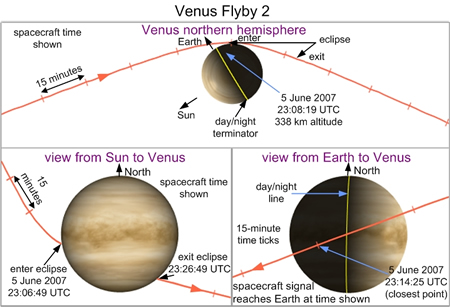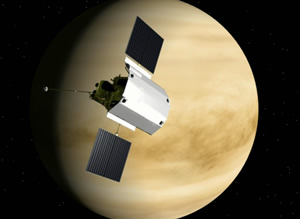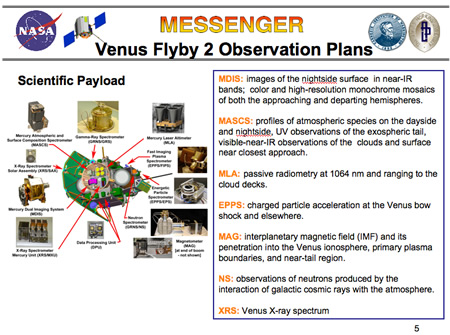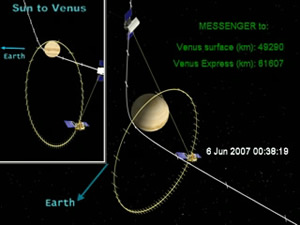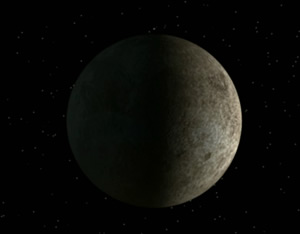MERCURY-BOUND MESSENGER READY FOR VENUS ENCOUNTER
June 4, 2007 at 2 p.m. EDT
Introduction
For the second time in less than a year, NASA's MErcury Surface, Space ENvironment, GEochemistry, and Ranging (MESSENGER) spacecraft will swing by Venus on June 5, 2007, to use the pull of the planet's gravity to guide it closer to Mercury's orbit. The encounter offers opportunities for new observations of the Venus atmosphere and cloud structure, space environment, and, perhaps even the surface. MESSENGER will also tag up with the European Venus Express spacecraft-currently orbiting Venus-to make novel observations of the Venus environment.
MESSENGER Panelist Biographies
Marilyn Lindstrom, MESSENGER Program Scientist
NASA Headquarters, Washington

MESSENGER's Program Scientist at NASA Headquarters is Dr. Marilyn Lindstrom. She is the liaison between the MESSENGER principal investigator and the science team and NASA program management on science matters. She is responsible for overseeing science planning, implementation, analysis and data archiving, but also for facilitating MESSENGER science. Dr. Lindstrom is also program scientist for the Mars Fundamental Research program, Astromaterials Curation and Planetary EPO. She previously managed Planetary Instruments and Mars Data Analysis Programs. Prior to coming to Headquarters she was curator of Antarctic meteorites at NASA Johnson Space Center in Houston, and a research scientist studying rocks from the Earth, Moon and Mars. She is particularly interested in comparative planetology of the terrestrial planets and is delighted to have a role in studying Mercury, the least known of these bodies.
Contact Information: 202.358.1254
e-mail:
marilyn.lindstrom-1@nasa.gov
Sean Solomon, MESSENGER Principal Investigator
The Carnegie Institution of Washington, Washington

As Principal Investigator for the MErcury Surface, Space ENvironment, GEochemistry, and Ranging (MESSENGER) mission, Sean Solomon heads a multi-institutional consortium of scientists and engineers who operate the small, efficient spacecraft, which launched in 2004 and will reach its target orbit in 2011.
To date, the only craft sent to Mercury was Mariner 10 in the 1970s, and it imaged less than half of the planet. With a suite of seven miniaturized instruments, MESSENGER will address questions that are key to understanding terrestrial planet evolution. Solomon's particular interests are to learn more about Mercury's bulk composition and what that tells us about planet formation in general; to investigate its volcanic, tectonic, and internal evolution; and to understand how the planet's magnetic field originated and determine the characteristics of Mercury's liquid outer core. Mariner 10 discovered that Mercury has a weak magnetic field, which may arise from an Earth-like electromagnetic dynamo in the planet's outer core. MESSENGER will investigate this question as well as the nature of the planet's thin atmosphere and the composition of the permanently shadowed polar deposits.
Solomon has also been a team member on a variety of other projects, including the Magellan mission to Venus, the Mars Orbiter Laser Altimeter (MOLA) investigation on the Mars Global Surveyor spacecraft, and the Plume-Lithosphere Undersea Mantle Experiment (PLUME) on Earth. The Magellan mission produced global radar image and altimetric maps of the surface of Venus. Data from MOLA have been used to construct precise topographical maps to understand Martian geology, geophysics, and atmospheric circulation. PLUME is a combined land and ocean-bottom seismic experiment to image the mantle beneath the Hawaiian hotspot. Solomon is leading the land section of this project.
Solomon balances his position as director of the Carnegie Institution of Washington's Department of Terrestrial Magnetism with research in planetary geology and geophysics, seismology, marine geophysics, and geodynamics. Prior to accepting his current position, he was a professor of geophysics at the Massachusetts Institute of Technology for more than 20 years. He is a member of the National Academy of Sciences, a fellow of the American Academy of Arts and Sciences, and a former president of the American Geophysical Union.
Contact Information: 202.478.8850
e-mail:
scs@dtm.ciw.edu
Eric Finnegan, MESSENGER Mission Systems Engineer
The Johns Hopkins University Applied Physics Laboratory, Laurel, MD

Eric Finnegan is a member of the Senior Professional Staff at The Johns Hopkins University Applied Physical Laboratory, joining the lab in 2004. He is presently the Mission Systems Engineer, responsible for all technical aspects of the of the NASA MESSENGER mission to Mercury. He has previously served as the lead systems engineer overseeing a combined industry and government team in the development of spacecraft bus standards in support of the Office of Force Transportation's multi-phase Operational Responsive Space Program. He has also lead a number of conceptual design efforts for space and near-space systems for both National Security and Civil space programs. Prior to joining the lab, he worked as a civil servant at the National Aeronautics and Space Administration Goddard Space Flight Center and was the Missions Systems Engineer and Project Technologist for the Space Technology 5 Project, part of the New Millennium Program. Previous employment experience included lead engineer for the Guidance, Navigation and Control (GNC) and Image Navigation and Registration (INR) subsystems in support of the Geostationary Operational Environmental Satellites (GOES) Program. He has also supported a variety of programs including DSCS, SORCE, Cassini, SP-100, Re-entry Vehicles, CONTOUR, MESSENGER, ICESAT, IMAGE, ACT, VCL. He has a BS, with honors, in Aerospace Engineering from the State University of New York at Buffalo, and an MS in Electrical Engineering from the University of Pennsylvania. After graduating from college, he participated in the General Electric Edison Engineering Program.
Contact Information: 240.228.1712
e-mail:
eric.finnegan@jhuapl.edu
Håkan Svedhem, Venus Express Project Scientist
European Space Agency, Noordwijk, The Netherlands

Håkan Svedhem, the Project Scientist for the European Space Agency's Venus Express Mission, was born in Göteborg, Sweden on 9 April 1958. he joined ESA at the ESTEC establishment in Noordwijk, The Netherlands, in 1984 to work in the Microwave Instrumentation section. In 1986 he transferred to the Space Science Department to work initially on interplanetary dust and related instrumentation. Dr. Svedhem took part in the studies and preparations for the Rosetta, Huygens and BepiColombo missions. In 2001 he worked as Study Scientist for the Cosmic Dune Mission and in 2002 he became the Project Scientist for the ESA Venus Express mission. His research interests include interplanetary dust and planetary atmospheres and surfaces. He has been co-investigator on nine experiments on Russian, Japanese and ESA planetary missions, was Team Leader for the Titan Radar Altimetry Team on the Huygens probe and has been actively involved in several additional space projects. He has authored or co-authored more than 70 scientific papers on subjects ranging from the flux of interstellar and interplanetary dust, to acoustic sounding in planetary atmospheres and space instrumentation design. He is married, with two sons and two daughters.
Contact Information: 202.478.8850
e-mail:
scs@dtm.ciw.edu
Resources
MESSENGER Completes Second Flyby of Venus, Makes Its Way toward First Flyby of Mercury in 33 Years (June 5, 2007)
Multimedia
Presenter #1 |
Marilyn Lindstrom, MESSENGER program scientist
NASA Headquarters, Washington
Image 1.1—Mercury Orbit Insertion
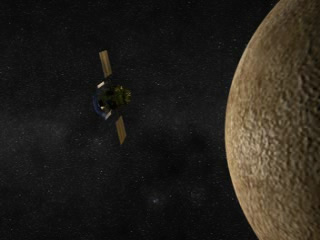
MESSENGER prepares to perform the Mercury orbit insertion burn.
(Click the image above to view the animation.)
|
Presenter #2 |
Eric Finnegan, MESSENGER mission systems engineer
The Johns Hopkins University Applied Physics Laboratory, Laurel, MD
Image 2.1—MESSENGER's Demanding Trajectory
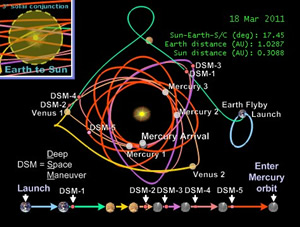 This animation depicts the demanding trajectory of the MESSENGER spacecraft during the cruise phase of the mission, from launch on August 3, 2004, through Mercury Orbit Insertion (MOI) on March 18, 2011. Shown here is a view of the inner planets’ motions looking down from the Ecliptic North Pole, where the line between the Sun and the Earth is held fixed in space. During MESSENGER’s 6 year, 7 month journey, it will fly by three planets: once by Earth at an altitude of approximately 2,300 kilometers (1,429 miles); twice by Venus at an altitude of approximately 3,000 kilometers (1,864 miles) and 330 kilometers (205 miles) and then three times by Mercury at an altitude of approximately 200 kilometers (124 miles). In addition to these flyby opportunities—critical to slowing the velocity of the spacecraft—MESSENGER will execute five deep space maneuvers using the on-board bi-propellant propulsion system, firing the main engine to further aid in slowing the spacecraft on its approach for Mercury orbit capture. The cruise phase of the mission concludes with the largest maneuver sequence for the mission, placing the spacecraft in an elliptical orbit around Mercury, passing within 200 kilometers (124 miles) of the surface every 12 hours. Also during the cruise phase, the relative geometry between the spacecraft, the Earth and the Sun, referred to as the Sun-Earth-Probe (SEP) angle, align such that communications between the spacecraft and the Deep Space Network is precluded. These superior conjunctions are estimated to start and end when the SEP angle is less than 3 degrees. There are nine of these conjunctions during cruise operations, the longest of which will occur on October 25, 2007 and lasts for 48 days.
(Click the image on the left to view the animation.) This animation depicts the demanding trajectory of the MESSENGER spacecraft during the cruise phase of the mission, from launch on August 3, 2004, through Mercury Orbit Insertion (MOI) on March 18, 2011. Shown here is a view of the inner planets’ motions looking down from the Ecliptic North Pole, where the line between the Sun and the Earth is held fixed in space. During MESSENGER’s 6 year, 7 month journey, it will fly by three planets: once by Earth at an altitude of approximately 2,300 kilometers (1,429 miles); twice by Venus at an altitude of approximately 3,000 kilometers (1,864 miles) and 330 kilometers (205 miles) and then three times by Mercury at an altitude of approximately 200 kilometers (124 miles). In addition to these flyby opportunities—critical to slowing the velocity of the spacecraft—MESSENGER will execute five deep space maneuvers using the on-board bi-propellant propulsion system, firing the main engine to further aid in slowing the spacecraft on its approach for Mercury orbit capture. The cruise phase of the mission concludes with the largest maneuver sequence for the mission, placing the spacecraft in an elliptical orbit around Mercury, passing within 200 kilometers (124 miles) of the surface every 12 hours. Also during the cruise phase, the relative geometry between the spacecraft, the Earth and the Sun, referred to as the Sun-Earth-Probe (SEP) angle, align such that communications between the spacecraft and the Deep Space Network is precluded. These superior conjunctions are estimated to start and end when the SEP angle is less than 3 degrees. There are nine of these conjunctions during cruise operations, the longest of which will occur on October 25, 2007 and lasts for 48 days.
(Click the image on the left to view the animation.)
|
| Image 2.2—The MESSENGER Spacecraft |

|
|

|
These sets of images present views of the MESSENGER spacecraft, in the deployed state; from the front and back (Left image) and from the bottom (Right image). The most recognizable feature of the spacecraft, the sun shade, is used to shield the spacecraft from solar radiation as the cruise trajectory and Mercury orbital operations place the spacecraft within 0.3AU of the sun. The locations for all seven instrument packages, including their individual instrument sensors are depicted. Note, the thermal blanket material that covers and insulates the spacecraft from cold space has been removed for clarity and viewing of the individual sensors.
|
|
Presenter #3 |
Sean Solomon, MESSENGER principal investigator
The Carnegie Institution of Washington, Washington
|
Presenter #4 |
Hakan Svedhem, Venus Express project scientist
European Space Agency, Noordwijk, The Netherlands
Image 4.1
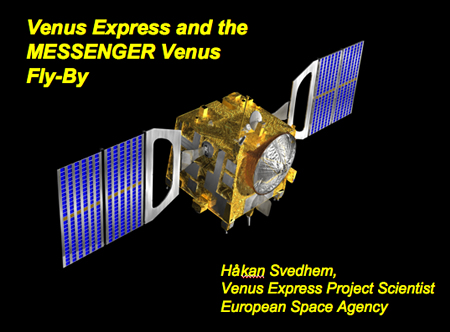
|
|
Image 4.2
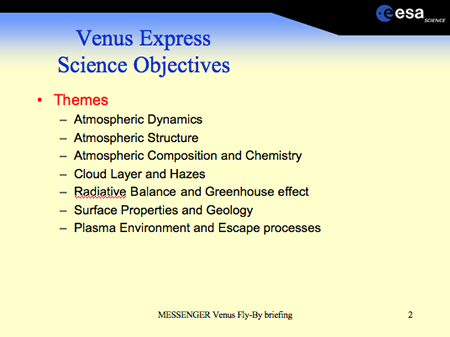
|
Image 4.3
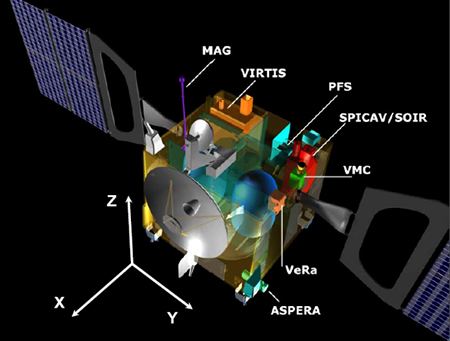
|
|
Image 4.4
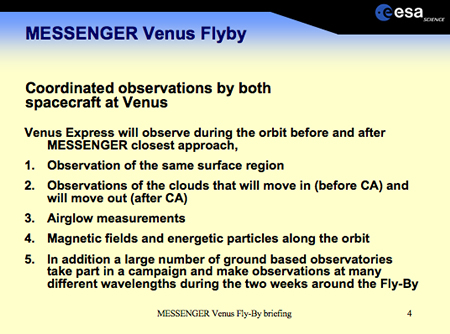 |
Image 4.5
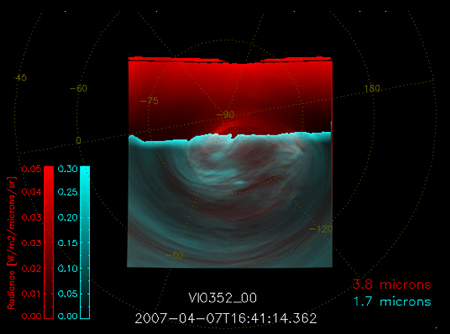
|
|
Image 4.6
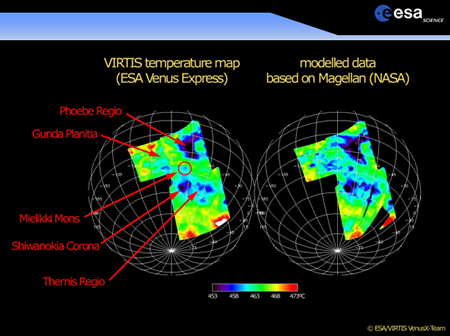 |
|
Contact Information
Paulette Campbell
Johns Hopkins University Applied Physics Laboratory
Laurel, Maryland
Phone: 240.228.6792
Dwayne Brown/Tabatha Thompson
NASA Headquarters
Washington, DC
Phone: 202.358.1726/3895
Tina McDowell
Carnegie Institution of Washington
Washington, DC
Phone: 202.939.1120
Monica Talevi
European Space Agency
Noordwijk, The Netherlands
Phone: +31 71 565 3223
Event Information
The NASA MESSENGER Media teleconference will take place on Monday, June 4, 2007 at 2 p.m. Eastern Standard Time. To participate in the teleconference, reporters in the United States should call 1-888-324-6998 and use the pass code "Venus." International reporters should call 1-210-234-0009. Audio of the teleconference will be streamed live at: http://www.nasa.gov/newsaudio.
 MESSENGER's Program Scientist at NASA Headquarters is Dr. Marilyn Lindstrom. She is the liaison between the MESSENGER principal investigator and the science team and NASA program management on science matters. She is responsible for overseeing science planning, implementation, analysis and data archiving, but also for facilitating MESSENGER science. Dr. Lindstrom is also program scientist for the Mars Fundamental Research program, Astromaterials Curation and Planetary EPO. She previously managed Planetary Instruments and Mars Data Analysis Programs. Prior to coming to Headquarters she was curator of Antarctic meteorites at NASA Johnson Space Center in Houston, and a research scientist studying rocks from the Earth, Moon and Mars. She is particularly interested in comparative planetology of the terrestrial planets and is delighted to have a role in studying Mercury, the least known of these bodies.
MESSENGER's Program Scientist at NASA Headquarters is Dr. Marilyn Lindstrom. She is the liaison between the MESSENGER principal investigator and the science team and NASA program management on science matters. She is responsible for overseeing science planning, implementation, analysis and data archiving, but also for facilitating MESSENGER science. Dr. Lindstrom is also program scientist for the Mars Fundamental Research program, Astromaterials Curation and Planetary EPO. She previously managed Planetary Instruments and Mars Data Analysis Programs. Prior to coming to Headquarters she was curator of Antarctic meteorites at NASA Johnson Space Center in Houston, and a research scientist studying rocks from the Earth, Moon and Mars. She is particularly interested in comparative planetology of the terrestrial planets and is delighted to have a role in studying Mercury, the least known of these bodies.  As Principal Investigator for the MErcury Surface, Space ENvironment, GEochemistry, and Ranging (MESSENGER) mission, Sean Solomon heads a multi-institutional consortium of scientists and engineers who operate the small, efficient spacecraft, which launched in 2004 and will reach its target orbit in 2011.
As Principal Investigator for the MErcury Surface, Space ENvironment, GEochemistry, and Ranging (MESSENGER) mission, Sean Solomon heads a multi-institutional consortium of scientists and engineers who operate the small, efficient spacecraft, which launched in 2004 and will reach its target orbit in 2011.  Eric Finnegan is a member of the Senior Professional Staff at The Johns Hopkins University Applied Physical Laboratory, joining the lab in 2004. He is presently the Mission Systems Engineer, responsible for all technical aspects of the of the NASA MESSENGER mission to Mercury. He has previously served as the lead systems engineer overseeing a combined industry and government team in the development of spacecraft bus standards in support of the Office of Force Transportation's multi-phase Operational Responsive Space Program. He has also lead a number of conceptual design efforts for space and near-space systems for both National Security and Civil space programs. Prior to joining the lab, he worked as a civil servant at the National Aeronautics and Space Administration Goddard Space Flight Center and was the Missions Systems Engineer and Project Technologist for the Space Technology 5 Project, part of the New Millennium Program. Previous employment experience included lead engineer for the Guidance, Navigation and Control (GNC) and Image Navigation and Registration (INR) subsystems in support of the Geostationary Operational Environmental Satellites (GOES) Program. He has also supported a variety of programs including DSCS, SORCE, Cassini, SP-100, Re-entry Vehicles, CONTOUR, MESSENGER, ICESAT, IMAGE, ACT, VCL. He has a BS, with honors, in Aerospace Engineering from the State University of New York at Buffalo, and an MS in Electrical Engineering from the University of Pennsylvania. After graduating from college, he participated in the General Electric Edison Engineering Program.
Eric Finnegan is a member of the Senior Professional Staff at The Johns Hopkins University Applied Physical Laboratory, joining the lab in 2004. He is presently the Mission Systems Engineer, responsible for all technical aspects of the of the NASA MESSENGER mission to Mercury. He has previously served as the lead systems engineer overseeing a combined industry and government team in the development of spacecraft bus standards in support of the Office of Force Transportation's multi-phase Operational Responsive Space Program. He has also lead a number of conceptual design efforts for space and near-space systems for both National Security and Civil space programs. Prior to joining the lab, he worked as a civil servant at the National Aeronautics and Space Administration Goddard Space Flight Center and was the Missions Systems Engineer and Project Technologist for the Space Technology 5 Project, part of the New Millennium Program. Previous employment experience included lead engineer for the Guidance, Navigation and Control (GNC) and Image Navigation and Registration (INR) subsystems in support of the Geostationary Operational Environmental Satellites (GOES) Program. He has also supported a variety of programs including DSCS, SORCE, Cassini, SP-100, Re-entry Vehicles, CONTOUR, MESSENGER, ICESAT, IMAGE, ACT, VCL. He has a BS, with honors, in Aerospace Engineering from the State University of New York at Buffalo, and an MS in Electrical Engineering from the University of Pennsylvania. After graduating from college, he participated in the General Electric Edison Engineering Program. Håkan Svedhem, the Project Scientist for the European Space Agency's Venus Express Mission, was born in Göteborg, Sweden on 9 April 1958. he joined ESA at the ESTEC establishment in Noordwijk, The Netherlands, in 1984 to work in the Microwave Instrumentation section. In 1986 he transferred to the Space Science Department to work initially on interplanetary dust and related instrumentation. Dr. Svedhem took part in the studies and preparations for the Rosetta, Huygens and BepiColombo missions. In 2001 he worked as Study Scientist for the Cosmic Dune Mission and in 2002 he became the Project Scientist for the ESA Venus Express mission. His research interests include interplanetary dust and planetary atmospheres and surfaces. He has been co-investigator on nine experiments on Russian, Japanese and ESA planetary missions, was Team Leader for the Titan Radar Altimetry Team on the Huygens probe and has been actively involved in several additional space projects. He has authored or co-authored more than 70 scientific papers on subjects ranging from the flux of interstellar and interplanetary dust, to acoustic sounding in planetary atmospheres and space instrumentation design. He is married, with two sons and two daughters.
Håkan Svedhem, the Project Scientist for the European Space Agency's Venus Express Mission, was born in Göteborg, Sweden on 9 April 1958. he joined ESA at the ESTEC establishment in Noordwijk, The Netherlands, in 1984 to work in the Microwave Instrumentation section. In 1986 he transferred to the Space Science Department to work initially on interplanetary dust and related instrumentation. Dr. Svedhem took part in the studies and preparations for the Rosetta, Huygens and BepiColombo missions. In 2001 he worked as Study Scientist for the Cosmic Dune Mission and in 2002 he became the Project Scientist for the ESA Venus Express mission. His research interests include interplanetary dust and planetary atmospheres and surfaces. He has been co-investigator on nine experiments on Russian, Japanese and ESA planetary missions, was Team Leader for the Titan Radar Altimetry Team on the Huygens probe and has been actively involved in several additional space projects. He has authored or co-authored more than 70 scientific papers on subjects ranging from the flux of interstellar and interplanetary dust, to acoustic sounding in planetary atmospheres and space instrumentation design. He is married, with two sons and two daughters.



